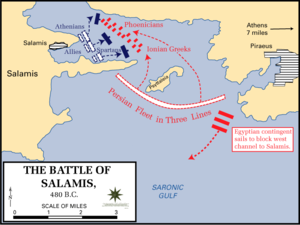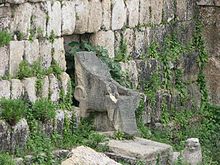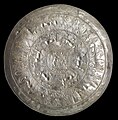https://en.wiki.x.io/wiki/Portal:Phoenicia/Sandbox
THE PHOENICIA PORTAL

The Phoenicians were an ancient Semitic group of people who lived in the Phoenician city-states along a coastal strip in the Levant region of the eastern Mediterranean, primarily modern Lebanon. They developed a maritime civilization which expanded and contracted throughout history, with the core of their culture stretching from Arwad in modern Syria to Mount Carmel. The Phoenicians extended their cultural influence through trade and colonization throughout the Mediterranean, from Cyprus to the Iberian Peninsula, evidenced by thousands of Phoenician inscriptions.
The Phoenicians directly succeeded the Bronze Age Canaanites, continuing their cultural traditions after the decline of most major Mediterranean basin cultures in the Late Bronze Age collapse and into the Iron Age without interruption. They called themselves Canaanites and referred to their land as Canaan, but the territory they occupied was notably smaller than that of Bronze Age Canaan. The name Phoenicia is an ancient Greek exonym that did not correspond precisely to a cohesive culture or society as it would have been understood natively. Therefore, the division between Canaanites and Phoenicians around 1200 BC is regarded as a modern and artificial construct.
The Phoenicians, known for their prowess in trade, seafaring and navigation, dominated commerce across classical antiquity and developed an expansive maritime trade network lasting over a millennium. This network facilitated cultural exchanges among major cradles of civilization, such as Mesopotamia, Greece and Egypt. The Phoenicians established colonies and trading posts across the Mediterranean; Carthage, a settlement in northwest Africa, became a major civilization in its own right in the seventh century BC.
The Phoenicians were organized in city-states, similar to those of ancient Greece, of which the most notable were Tyre, Sidon, and Byblos. Each city-state was politically independent, and there is no evidence the Phoenicians viewed themselves as a single nationality. While most city-states were governed by some form of kingship, merchant families probably exercised influence through oligarchies. After reaching its zenith in the ninth century BC, the Phoenician civilization in the eastern Mediterranean gradually declined due to external influences and conquests such as by the Neo-Assyrian Empire and Achaemenid Empire. Yet, their presence persisted in the central, southern and western Mediterranean until the destruction of Carthage in the mid-second century BC. — Read more about Phoenicia, its mythology and languagehttps://en.wiki.x.io/w/index.php?title=Portal:Phoenicia/Sandbox&action=edit
Read or find an article
The Readers' FAQ and our about page contain the most commonly sought information about Wikipedia.
For simple searches, there is a search box at the top of every page. Type what you are looking for in the box. Partial matches will appear in a dropdown list. Select any page in the list to go to that page. Or, select the magnifying glass "Go" button, or press ↵ Enter, to go to a full search result. For advanced searches, see Help:Searching.
There are other ways to browse and explore Wikipedia articles; many can be found at Wikipedia:Contents. Also see our disclaimer for cautions about Wikipedia's limitations.
Edit an article
Contributing is easy: see how to edit a page. For a quick summary on participating, see contributing to Wikipedia, and for a friendly tutorial, see our introduction. For a listing of introductions and tutorials by topic, see getting started. The Simplified Manual of Style and Cheatsheet can remind you of basic wiki markup.
Be bold in improving articles! When adding facts, please provide references so others may verify them. If you are affiliated with the article subject, please see our conflict of interest guideline.
The simple guide to vandalism cleanup can help you undo malicious edits.
If you're looking for places you can help out, the Task Center is the place to go, or check out what else is happening at the community portal. You can practice editing and experiment in a sandboxyour sandbox.
,
 Featured article
-
Featured article
-
This is a Featured article, which represents some of the best content on English Wikipedia..
The Battle of Bagradas, the Bagradas, or the Bagradas River (the ancient name of the Medjerda) may refer to:
- Battle of the Bagradas River (255 BC), also known as the Battle of Tunis, during the First Punic War
- Battle of the Bagradas River (240 BC), also known as the Battle of the Macar, during the Mercenary War
- Battle of the Bagradas River (203 BC), usually known as the Battle of the Great Plains, during the Second Punic War
- Battle of the Bagradas River (49 BC), a battle during the Roman civil war between Caesar and Pompey
- Battle of the Bagradas River (536), a battle between the rebel leader Stotzas and Byzantine commander Belisarius (Full article...)
 Good article
-
Good article
-
This is a Good article, an article that meets a core set of high editorial standards.
The Battle of Salamis (/ˈsæləmɪs/ SAL-ə-miss) was a naval battle fought in 480 BC, between an alliance of Greek city-states under Themistocles, and the Achaemenid Empire under King Xerxes. It resulted in a victory for the outnumbered Greeks.
The battle was fought in the straits between the mainland and Salamis, an island in the Saronic Gulf near Athens, and marked the high point of the second Persian invasion of Greece. It was arguably the largest naval battle of the ancient world, and marked a turning point in the invasion. (Full article...)
Selected Phoenician inscriptions and language articles -
The Baal Lebanon inscription, known as KAI 31, is a Phoenician inscription found in Limassol, Cyprus in eight bronze fragments in the 1870s. At the time of their discovery, they were considered to be the second most important finds in Semitic palaeography after the Mesha stele.
It was purchased in 1874–75 by a Limassol merchant named Laniti from a scrap metal dealer, who did not know of their previous provenance. A copy was passed to Julius Euting, and after Charles Simon Clermont-Ganneau secured its acquisition by the Cabinet des Médailles, the inscription was published in full by Ernest Renan in 1877.
It is particularly notable for having mentioned Hiram I. It is the only Phoenician inscription to suggest a "colonial" system amongst the Phoenician domains. (Full article...)
Selected Phoenician mythology articles -
Eshmun (or Eshmoun, less accurately Esmun or Esmoun; Phoenician: 𐤀𐤔𐤌𐤍 ʾšmn; Akkadian: 𒅀𒋢𒈬𒉡 Yasumunu) was a Phoenician god of healing and the tutelary god of Sidon. (Full article...)
General images
Categories
Related portals
Wikiproject
Other Wikimedia and Wikiportals
The following Wikimedia Foundation sister projects provide more on this subject:
-
Commons
Free media repository -
Wikibooks
Free textbooks and manuals -
Wikidata
Free knowledge base -
Wikinews
Free-content news -
Wikiquote
Collection of quotations -
Wikisource
Free-content library -
Wikiversity
Free learning tools -
Wikivoyage
Free travel guide -
Wiktionary
Dictionary and thesaurus
Parent portal: Lebanon



















































